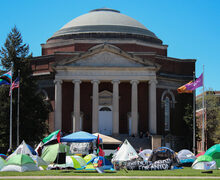Raymon Elozua’s “Structure/Dissonance” exhibit contemplates decay, regeneration
Cassandra Roshu | Contributing Photographer
Elozua’s exhibit “Structure/Dissonance” is currently at the Everson Museum, and will be there until the end of the year.
To support student journalism and the content you love, become a member of The Daily Orange today.
In the 40s and 50s, the American manufacturing economy was booming — particularly steel. Laborers dug out raw materials to be melted, mixed, shut into a furnace, cooked, hardened and shaped. And for a while, everyone profited.
But in 1980, employment in the steel mills halved when global competition outpaced American output. Many American blue collar workers who had only ever spent the days in hot sweat of the steel mill were laid off, left unable to provide for the family that the steel mills had offered them the situation to create.
Eventually, the mills themselves were abandoned. Once loud, smoky centers for creating the beams and banisters that made up the American industrial landscape lay quiet, still, rusted and corroded.
The Everson’s exhibit, “Structure/Dissonance,” which is on display until the end of the year, captures this time period through the work of artist Raymon Elozua. But the museum can’t begin to capture his entire body of work, so the exhibit focuses on three materials: glass, steel and ceramic and how they wrap around and into each other in Elozua’s creations.
Elozua was born into the steel industry to two immigrant parents on the south side of Chicago, blue-collar workers. To pay for college, Elozua worked at a steel mill because he wanted to make an impact, to do hard work, to sweat, he said. He took U.S. history classes where he fell further into his niche history holes of American infrastructure and labor, and he took ceramics.
Elozua wasn’t good at throwing pottery, so it was a happy accident when his non-functional bowls that needed posts to stand up were rightfully noticed for their artistic merit. Combined with his interest in Americana aesthetics, he got a gallery spot in New York City with the same curator who discovered Andy Warhol.
That spot is what first gave Elozua the space to expand on his different interests in American history, something he said he is a lot better educated in than art. His work became as eclectic as it is intensive — wire sculptures of sirens, demons, rusty buckets, AI, photography of abandoned resort towns, found footage of steel laborers, kitschy websites, little dioramas of old railroad systems, billboards, steel mills. He creates in unexpected materials: in ceramic made to look like wood, in steel meant to look like bones, in clay meant to look like flesh.
The thread that follows from Elozua’s very first artistic works in the late 70s to the present is this notion of decay and loss, that he said comes from being a child of immigrant parents. His early works are photorealist billboards and mills, made of clay to look like collapsing wood.
In peeling layers of plaster and old signage, they read “For Lease,” “EZ CREDIT” “We Buy 50% Off” and more, complete with haphazard vague structures that give a sense of the side-of-the-highway environment. He didn’t use models for these, just memory.
But these billboards, made almost 50 years ago, aren’t included in the Everson’s exhibit. Though, there’s traces of them, in the rusted grids and peeling paint of his more recent works that are exhibited. My favorites from this exhibit are his latest — sprawling steel, ceramics, mirrors and blown glass trapped and gasping for air, called “Clarity in Confusion.”
The “Clarity in Confusion” series looks like a steel mill if you exploded it from the middle and suspended it as each beam ejected itself in a different direction. They are coated in all kinds of painted colors, globbed on like gesso, with haphazard gears and chains that look like they could give you tetanus if you get too close. But it’s not really rust— it’s clay that Elozua cracked on purpose, for more decay, more decomposition, more dilapidation, more America.

Cassandra Roshu | Contributing Photographer
Sliding between all the dripping structures are little rectangular slits of mirror, that reflect on each other, on the viewer. It gives the pieces more dimension and movement. As you walk around the sculptures, you see deeper into the little worlds within each. Each metal structure shifts and fits together in different iterations — at one moment a machine, the next, a garden.
And intertwined between all these jutting grids of steel and ceramic and mirrors are huge blown glass, blown in and around steel spirals. In “Clarity in Confusion IV,” it looks like a misshapen cherry-red heart. It’s like some kind of tropism, like a tree that grew into the bench placed under it — misshapen yet flourishing.
In that way, it’s a look to the future, there’s hope in that weird glass balloon. It’s the topsoil, the ivy that works its way up the legs of an abandoned mill, the moss that coats the floor where a carpet one was.
Elozua’s art is honest about brokenness, about how it plagues our American systems, how it has distorted the value of the core tenants of our society: labor, transportation, farming and production. But that doesn’t mean he’s not looking for the beauty in it too. These pieces examine the little artistries in industry, and his latest works even hint at a path of regeneration.

Published on October 5, 2022 at 11:38 pm
Contact Sydney: [email protected]




